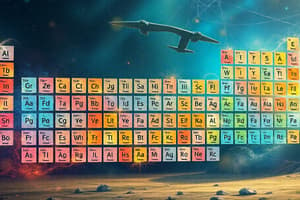Podcast
Questions and Answers
What defines the organization of elements in the periodic table?
What defines the organization of elements in the periodic table?
- Atomic mass
- Number of neutrons
- Atomic number (correct)
- Number of electrons
Metals tend to gain electrons to form anions.
Metals tend to gain electrons to form anions.
False (B)
Give an example of a highly reactive nonmetal found in Group 17 of the periodic table.
Give an example of a highly reactive nonmetal found in Group 17 of the periodic table.
fluorine
Alkali Metals are found in Group ________ of the periodic table.
Alkali Metals are found in Group ________ of the periodic table.
Match the following element group with its characteristics:
Match the following element group with its characteristics:
Flashcards are hidden until you start studying
Study Notes
Periodic Table
- A tabular arrangement of elements, organized by their atomic number (number of protons in the nucleus)
- Elements with similar properties and electron configurations are placed in the same group (vertical column)
- Elements with the same number of electron shells are placed in the same period (horizontal row)
Metals and Nonmetals
- Metals:
- Typically shiny, malleable, and good conductors of electricity
- Tend to lose electrons to form cations (positive ions)
- Examples: sodium, iron, copper
- Nonmetals:
- Typically dull, brittle, and poor conductors of electricity
- Tend to gain electrons to form anions (negative ions)
- Examples: carbon, nitrogen, oxygen
Halogens
- A group of highly reactive nonmetals
- Found in Group 17 of the periodic table
- Examples: fluorine, chlorine, bromine, iodine, astatine
- Tend to gain electrons to form anions (negative ions)
Alkali and Alkaline Earth Metals
- Alkali Metals:
- Found in Group 1 of the periodic table
- Highly reactive and tend to lose one electron to form a cation
- Examples: lithium, sodium, potassium, rubidium, cesium
- Alkaline Earth Metals:
- Found in Group 2 of the periodic table
- Less reactive than alkali metals and tend to lose two electrons to form a cation
- Examples: magnesium, calcium, strontium, barium, radium
Noble Gases
- A group of unreactive gases
- Found in Group 18 of the periodic table
- Examples: helium, neon, argon, krypton, xenon, radon
- Tend to have full outer energy levels, making them unreactive
Chemical Reactivity
- The ability of an element to react with other elements to form compounds
- Influenced by the element's position in the periodic table and its electron configuration
- Increases from left to right across a period and decreases from top to bottom within a group
Block of Elements
- A horizontal row of elements in the periodic table
- Elements in the same block have similar electron configurations and chemical properties
- Blocks are named based on the subshell being filled:
- s-block (first two columns)
- p-block (next six columns)
- d-block (next ten columns)
- f-block (inner transition metals)
Periodic Table
- Organized by atomic number (number of protons in the nucleus)
- Elements with similar properties and electron configurations are placed in the same group (vertical column)
- Elements with the same number of electron shells are placed in the same period (horizontal row)
Metals and Nonmetals
- Metals: shiny, malleable, good conductors of electricity, tend to lose electrons to form cations
- Examples of metals: sodium, iron, copper
- Nonmetals: dull, brittle, poor conductors of electricity, tend to gain electrons to form anions
- Examples of nonmetals: carbon, nitrogen, oxygen
Halogens
- Highly reactive nonmetals
- Found in Group 17 of the periodic table
- Examples: fluorine, chlorine, bromine, iodine, astatine
- Tend to gain electrons to form anions (negative ions)
Alkali and Alkaline Earth Metals
- Alkali metals: found in Group 1, highly reactive, tend to lose one electron to form a cation
- Examples of alkali metals: lithium, sodium, potassium, rubidium, cesium
- Alkaline earth metals: found in Group 2, less reactive, tend to lose two electrons to form a cation
- Examples of alkaline earth metals: magnesium, calcium, strontium, barium, radium
Noble Gases
- Unreactive gases
- Found in Group 18 of the periodic table
- Examples: helium, neon, argon, krypton, xenon, radon
- Tend to have full outer energy levels, making them unreactive
Chemical Reactivity
- Influenced by the element's position in the periodic table and its electron configuration
- Increases from left to right across a period and decreases from top to bottom within a group
Block of Elements
- Named based on the subshell being filled
- s-block: first two columns
- p-block: next six columns
- d-block: next ten columns
- f-block: inner transition metals
Studying That Suits You
Use AI to generate personalized quizzes and flashcards to suit your learning preferences.




